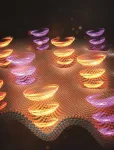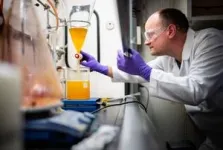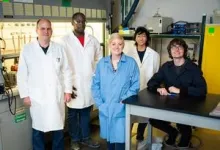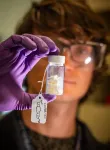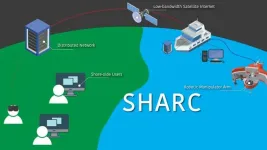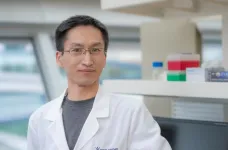(Press-News.org) A new approach to quantum light emitters generates a stream of circularly polarized single photons, or particles of light, that may be useful for a range of quantum information and communication applications. A Los Alamos National Laboratory team stacked two different, atomically thin materials to realize this chiral quantum light source.
“Our research shows that it is possible for a monolayer semiconductor to emit circularly polarized light without the help of an external magnetic field,” said Han Htoon, scientist at Los Alamos National Laboratory. “This effect has only been achieved before with high magnetic fields created by bulky superconducting magnets, by coupling quantum emitters to very complex nanoscale photonics structures or by injecting spin-polarized carriers into quantum emitters. Our proximity-effect approach has the advantage of low-cost fabrication and reliability.”
The polarization state is a means of encoding the photon, so this achievement is an important step in the direction of quantum cryptography or quantum communication.
“With a source to generate a stream of single photons and also introduce polarization, we have essentially combined two devices in one,” Htoon said.
Indentation key to photoluminescence
As described in Nature Materials, the research team worked at the Center for Integrated Nanotechnologies to stack a single-molecule-thick layer of tungsten diselenide semiconductor onto a thicker layer of nickel phosphorus trisulfide magnetic semiconductor. Xiangzhi Li, postdoctoral research associate, used atomic force microscopy to create a series of nanometer-scale indentations on the thin stack of materials. The indentations are approximately 400 nanometers in diameter, so over 200 of such indents can easily be fit across the width of a human hair.
The indentations created by the atomic microscopy tool proved useful for two effects when a laser was focused on the stack of materials. First, the indentation forms a well, or depression, in the potential energy landscape. Electrons of the tungsten diselenide monolayer fall into the depression. That stimulates the emission of a stream of single photons from the well.
The nanoindentation also disrupts the typical magnetic properties of the underlying nickel phosphorus trisulfide crystal, creating a local magnetic moment pointing up out of the materials. That magnetic moment circularly polarizes the photons being emitted. To provide experimental confirmation of this mechanism, the team first performed high magnetic field optical spectroscopy experiments in collaboration with National High Magnetic Field Laboratory’s Pulsed Field Facility at Los Alamos. The team then measured the minute magnetic field of the local magnetic moments in collaboration with the University of Basel in Switzerland.
The experiments proved that the team had successfully demonstrated a novel approach to control the polarization state of a single photon stream.
Encoding quantum information
The team is currently exploring ways to modulate the degree of circular polarization of the single photons with the application of electrical or microwave stimuli. That capability would offer a way to encode quantum information into the photon stream.
Further coupling of the photon stream into waveguides — microscopic conduits of light — would provide the photonic circuits that allow the propagation of photons in one direction. Such circuits would be the fundamental building blocks of an ultra-secure quantum internet.
The paper: “Proximity Induced Chiral Quantum Light Generation in Strain-Engineered WSe2/NiPS3 Heterostructures.” Nature Materials. DOI: 10.1038/s41563-023-01645-7
The funding: Laboratory Directed Research and Development (LDRD) program at Los Alamos National Laboratory; the U.S. Department of Energy Basic Energy Sciences, QIS Infrastructure Development Program; and the Quantum Science Center, a national QIS Research Center supported by the DOE Office of Science.
END
New quantum device generates single photons and encodes information
Approach is a step toward using single photons in quantum communication and information processing
2023-08-24
ELSE PRESS RELEASES FROM THIS DATE:
Making materials more durable through science
2023-08-24
ALBUQUERQUE, N.M. — A team at Sandia National Laboratories developed a molecule that helps change the way some materials react to temperature fluctuations, which makes them more durable. It’s an application that could be used in everything from plastic phone cases to missiles.
Polymers, which include various forms of plastics, are made up of many smaller molecules, bonded together. This bond makes them especially strong and an ideal product to be used to protect delicate components in a wide variety of items. But with time, use and exposure to different environments, all materials begin to deteriorate.
Hot ...
New framework for oceanographic research provides potential for broader access to deep sea scientific exploration
2023-08-24
Woods Hole, Mass. (August 23, 2023) -- Scientific exploration of the deep ocean has largely remained inaccessible to most people because of barriers to access due to infrastructure, training, and physical ability requirements for at-sea oceanographic research.
Now, a new and innovative framework for oceanographic research provides a way for shore-based scientists, citizen scientists, and the general public to seamlessly observe and control robotic sampling processes.
The Shared Autonomy for Remote Collaboration (SHARC) framework “enables remote participants to conduct shipboard operations and control ...
How pre-eclampsia accelerates aging in women
2023-08-24
ROCHESTER, Minnesota — Pre-eclampsia, a life-threatening surge in blood pressure, is an enigmatic condition. Each year, it causes the deaths of more than 70,000 women worldwide. Because scientists do not know what causes it, they lack targeted strategies to treat it.
Delivery, the only available therapy, is not the cure it is often made out to be, according to Vesna D. Garovic, M.D., Ph.D., a nephrologist at Mayo Clinic in Rochester, Minnesota, who has devoted her career to studying this common pregnancy complication.
"Even after delivery, women ...
Sweet corn yield at the mercy of the environment, except for one key factor
2023-08-24
URBANA, Ill. — A new analysis from the University of Illinois Urbana-Champaign and the USDA-Agricultural Research Service (ARS) has identified the top factors accounting for yield variability in processing sweet corn (used for canned and frozen products), including one within the control of processors.
“We used a very robust approach to account for sweet corn yield with field-level data across some 16,000 fields and 27 years. Year and production region were the two most important variables, which makes ...
Cambridge and ISPA scientists create a tool to identify individuals at risk of developing different myeloid leukemias
2023-08-24
Scientists have created a new test for identifying people at risk of developing acute myeloid leukaemia and related cancers, years before they do. The new platform, ‘MN-predict’, will allow doctors and scientists to identify those at risk and to design new treatments to prevent them from developing these potentially lethal cancers.
Researchers at the Wellcome-MRC Cambridge Stem Cell Institute (CSCI), the University of Cambridge’s Department of Haematology, and Instituto de Investigación Sanitaria del Principado de Asturias (ISPA) analysed data from more than 400,000 individuals participating ...
Repairing broken brain circuits may offer path to new Parkinson’s treatments
2023-08-24
GRAND RAPIDS, Mich. (August 24, 2023) — Van Andel Institute scientists have identified a series of processes that help the brain adapt to damage caused by breakdowns in circuits that govern movement, cognition and sensory perception.
Because such breakdowns contribute to Parkinson’s disease, the findings may one day help researchers optimize current treatments or develop new ones that repair or bypass the broken circuits.
A study describing the findings published this week in the journal Science Advances.
“Our work highlights the importance ...
MSK Research Highlights, August 24, 2023
2023-08-24
New research from Memorial Sloan Kettering Cancer Center (MSK) and the Sloan Kettering Institute — a hub for basic science and translational research within MSK — suggests a method for revealing DNA repair “scars” could help make treatment decisions in BRCA1- and BRCA2-deficient cancers; modified a bacteria-made compound to target mutant KRAS-driven cancers; and shed new light on brain metastasis in non-small cell lung cancer.
New method for revealing DNA repair “scars” ...
Study uncovers genetic risk factors for heart failure
2023-08-24
In a new study co-led by investigators at the United States Department of Veterans Affairs and Brigham and Women’s Hospital, a founding member of the Mass General Brigham healthcare system, a global team of scientists conducted one of the largest genetic association studies on heart failure to date. Using genomic data from over 90,000 heart failure patients and more than a million controls, the team identified 39 genetic mutations associated with heart failure, 18 of which had not been reported previously.
The researchers also pinpointed seven druggable proteins that, when targeted with specially ...
Training immune cells to remove ‘trash’ helps resolve lung inflammation
2023-08-24
Inflammation is a standard part of our bodies’ immune system response. But sometimes this response becomes hyperactivated in our lungs, causing inflammation to continue unchecked, which can be fatal. Many deaths from COVID-19 have been due to excessive inflammation, which results in acute lung injury.
A group of researchers at the University of Illinois Chicago have investigated how lungs counterbalance inflammation. Their work points to cells in the lung that reduce inflammation by removing ...
A new pathway to regenerate myelin discovered
2023-08-24
A study led by Dr. Hyun Kyoung Lee, associate professor at Baylor College of Medicine and investigator at the Jan and Dan Duncan Neurological Research Institute at Texas Children’s Hospital, has discovered a new biological mechanism to regenerate and repair myelin, a protective sheath that insulates neuronal fibers and plays a vital role in ensuring rapid and accurate neurotransmission. The Duncan NRI team found novel roles for the Dishevelled associated activator of morphogenesis 2 (Daam2) protein and CK2α kinase in regulating myelin repair and regeneration. The study was published in the Proceedings of the National ...
LAST 30 PRESS RELEASES:
Heart-brain connection: international study reveals the role of the vagus nerve in keeping the heart young
Researchers identify Rb1 as a predictive biomarker for a new therapeutic strategy in some breast cancers
Survey reveals ethical gaps slowing AI adoption in pediatric surgery
Stimulant ADHD medications work differently than thought
AI overestimates how smart people are, according to HSE economists
HSE researchers create genome-wide map of quadruplexes
Scientists boost cell "powerhouses" to burn more calories
Automatic label checking: The missing step in making reliable medical AI
Low daily alcohol intake linked to 50% heightened mouth cancer risk in India
American Meteorological Society announces Rick Spinrad as 2026 President-Elect
Biomass-based carbon capture spotlighted in newly released global climate webinar recording
Illuminating invisible nano pollutants: advanced bioimaging tracks the full journey of emerging nanoscale contaminants in living systems
How does age affect recovery from spinal cord injury?
Novel AI tool offers prognosis for patients with head and neck cancer
Fathers’ microplastic exposure tied to their children’s metabolic problems
Research validates laboratory model for studying high-grade serous ovarian cancer
SIR 2026 delivers transformative breakthroughs in minimally invasive medicine to improve patient care
Stem Cell Reports most downloaded papers of 2025 highlight the breadth and impact of stem cell research
Oxford-led study estimates NHS spends around 3% of its primary and secondary care budget on the health impacts of heat and cold in England
A researcher’s long quest leads to a smart composite breakthrough
Urban wild bees act as “microbial sensors” of city health.
New study finds where you live affects recovery after a hip fracture
Forecasting the impact of fully automated vehicle adoption on US road traffic injuries
Alcohol-related hospitalizations from 2016 to 2022
Semaglutide and hospitalizations in patients with obesity and established cardiovascular disease
Researchers ‘listen in’ to embryo-mother interactions during implantation using a culture system replicating the womb lining
How changing your diet could help save the world
How to make AI truly scalable and reliable for real-time traffic assignment?
Beyond fragmented markets: A new framework for efficient and stable ride-pooling
Can shape priors make road perception more reliable for autonomous driving?
[Press-News.org] New quantum device generates single photons and encodes informationApproach is a step toward using single photons in quantum communication and information processing
